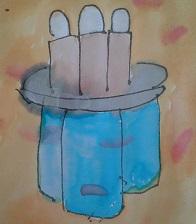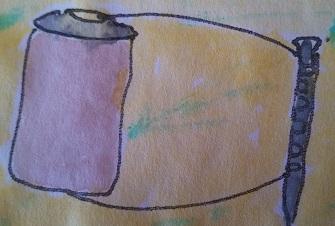SCIENCE
PART I: THE PORTAL
COMPASS
Tilly made a compass to find the directions in the room with the picture of a cave
Materials: sewing needle, magnet, piece of cork, bowl
STEP ONE: Fill bowl ¾ full of water
STEP TWO: Place cork in center of water
STEP THREE: Rub the magnet along the needle from eye to point, 20 times
STEP FOUR: Place needle on top of cork
When it is done bobbing it will be pointing north.
Use a regular compass to see if it worked
What’s up? A compass works by detecting the Earth’s magnetic fields.
This compass is a light weight magnetized needle, on a free floating pivot.
Since opposites attract the southern pole of the needle is attracted to
the Earth’s magnetic north pole.
DRAG
After the cloth opened and fluttered to the ground. Tilly used drag to assist her when she tried to toss the burial cloth.
Materials: two pieces of 8 ½ by 11 paper
STEP ONE: Crumple one piece of paper
STEP TWO: Extend arms at shoulder level
STEP THREE: Hold flat paper in one hand
STEP FOUR: Hold crumpled paper in the other
STEP FIVE: Drop both pieces at the same time
Which hit the ground first?
STEP SIX: Repeat steps two and three and four
STEP SEVEN: Toss paper toward another person
Which was easier to control?
What’s up? Drag slows an object’s movement through the air. The flat paper had more drag, so it fell at a slower speed, even though the two paper objects had the same weight
PART II: The Coin
PART II: The Coin
LAYER LIQUIDS
How did Hadji Ali, the Amazing Regurgitator layer liquids?
Materials: 1/3 cup measuring cup, pancake syrup,
cooking oil, water, clear drinking glass
cooking oil, water, clear drinking glass
STEP ONE: Pour 1/3 cup syrup into the glass
STEP TWO: Pour 1/3 cup oil into the glass
STEP THREE: Pour 1/3 cup water into the glass
What’s up? Density causes liquids to form layers by weight of the liquid.
FLIP IT
How did Tilly get the coin into her hand?
Materials: cup, 3x5 index card, penny
STEP ONE: Place the index card across the top of the cup
STEP TWO: Place the penny in the middle of the index card
STEP THREE: Form a circle with thumb and index finger
STEP FOUR: Lower your thumb, releasing index finger
Flick the edge of the index card
What’s up? Newton’s First Law of Motion
states that an object tends stay at rest unless an outside force acts on it.
When you flick the card it moves away while gravity, an outside force,
pulls the penny into the glass

When you flick the card it moves away while gravity, an outside force,
pulls the penny into the glass
DROP IT
For a more spectacular demonstration try this
Materials: 3 drinking glasses, water, pie pan,
3 cardboard tubes from toilet paper rolls, 3 eggs, broom, table
3 cardboard tubes from toilet paper rolls, 3 eggs, broom, table
STEP ONE: Fill the glasses ¾ full of water.
STEP TWO: Stack up the materials at edge of table, using steps 3-7
STEP THREE: Arrange the glasses in a triangle, touching in the middle
STEP FOUR: Place the pie plate on top of the glasses
STEP FIVE: Arrange the cardboard tube so the opening on the bottom is
directly over a glass of water.
directly over a glass of water.
STEP SIX: Repeat with the other 2 cardboard tubes
STEP SEVEN: Balance an egg in the top of each cardboard tube
STEP EIGHT: Make certain the edge of the pie pan is at edge of table
STEP NINE: Stand the broom at the edge of the table so that the handle
touches the pie pan. The bristles should be on the floor
touches the pie pan. The bristles should be on the floor
STEP TEN: Step on the bristles of the broom to hold it in place.
STEP ELEVEN: Pull back the broom handle toward you and then release it
so the broom hits the edge of pie pan.
so the broom hits the edge of pie pan.
If done correctly, the eggs should drop into the glasses without breaking.
STATIC ELECTRICITY
When Tilly touched the doorknob of Auntie Gabby’s house she felt a tingle.
This was due to static electricity.
When Tilly touched the doorknob of Auntie Gabby’s house she felt a tingle.
This was due to static electricity.
Materials: balloon
STEP ONE: Blow up and tie a balloon
STEP TWO: Rub the balloon on your hair
STEP THREE: Place balloon on wall, let go
The balloon should stick to the wall
What’s Up? When two objects are rubbed together one will lose electrons and the other will gain them. This can create static electricity.
The static electricity on the balloon is strong enough to attract the wall.
PART III: Quicksilver

ELECTROMAGNET
Melinda used an electromagnet to pick up the pieces of the meteor
Melinda used an electromagnet to pick up the pieces of the meteor
Materials: nail, wire, D battery, paper clips, wire cutters or scissors
STEP ONE: Remove the insulation from each end of the wire
STEP TWO: Wrap the wire around the nail 20 times
STEP THREE: Attach the wires to the battery, one on each end
STEP FOUR: Place paper clips on table
STEP FIVE: Touch the end of the nail to the paper clips
What’s up? As the electricity flows through the wire,
it stirs up electrons creating a magnetic field.
MOMEMTUM
How did Tilly get the ball out from under the throne?
MATERIALS: 2 yardsticks, tape, 6 marbles
STEP ONE: Make a track: tape the ends of the yardsticks to a
tabletop parallel to each other, ½ inch apart.
STEP TWO: Put 5 marbles in the middle of the track
STEP THREE: Place one marble near the end of the track
STEP FOUR: Flick the single marble so it rolls into the others
STEP FIVE: Put 4 marbles in the middle of the track and
the remaining 2 marbles near the end of the track
STEP SIX: Flick the 2 marbles so they roll into the others
STEP SEVEN: Try other combinations of resting marbles and
marbles that are rolled into them
What’s up? Momentum can be transferred. When the moving object
hits another object it loses its momentum and stops.
The object that was hit gains momentum and begins to move.
QUICKSAND
Lonnie was panicked when he fell into quicksand.
Try making a substance with the properties of quicksand.
Materials: cornstarch, water, measuring cup, bowl, spoon
STEP ONE: In the bowl, combine 1 cup water and 1 ¼ cups cornstarch
to form a mixture that looks like heavy whipping cream and has
the consistency of honey
STEP TWO: After making the mixture, gently poke your finger through
the surface of the cornstarch-water mixture.
STEP THREE: Try punching the cornstarch-water mixture
What’s up? Quicksand is a non-Newtonian fluid.
It does not behave the same way liquids do.
When you punch the mixture it disturbs the cornstarch-water mixture
and changes it into a more cement like form.
PART IV: Foo Fighters
SNOW GLOBE
Auntie Margie said that the poltergeists became intolerable and one day she and Bruno “... were awakened when the house rotated back and forth and objects swirled around the room. It was as if we were inside a huge snow globe.”
MATERIALS: Jar with lid that seals tightly, plastic figurine, water,
KARO light corn syrup, glitter, spoon
STEP ONE: Add water to the jar
STEP TWO: Add a small amount of light KARO syrup
STEP THREE: Add glitter and plastic figurine, stir
STEP FOUR: Add more water so the jar is filled
STEP FIVE: Place lid on jar
STEP SIX: Turn jar over
Shake to activate snow globe
WHAT’S UP? The denser a liquid is, the easier it is for an object to float
Corn syrup is denser than water. So the glitter will fall more slowly.
CONDUCT ELECTRICITY
In “The Coin”, Lonnie used the wooden handle of the parasol to
stop the flow of electricity.
stop the flow of electricity.
In “Foo Fighters”, Tilly and Melinda used their belts to prevent them
from getting a shock from the electrical wires.
Materials: 2 D batteries, three insulated wires with clips on both ends,
small light bulb with holder, masking tape or battery holders
miscellaneous objects for testing STEP ONE: Plug light bulb into light bulb holder
STEP TWO: Tape or use battery holder to keep the batteries together, so they are end to end:negative (-) to positive (+) touching
STEP THREE: Clip one wire to the light bulb holder
STEP FOUR: Clip the other end of the wire to one of the batteries
STEP FIVE: Clip the second wire to opposite side of light bulb holder
STEP SIX: Clip the third wire to the opposite side of the batteries
STEP SEVEN: Complete a circle by clipping different objects between
the free ends of wires
Did the light bulb light?
If it lights, the object is a conductor
If it doesn’t light, the object is an insulator
What’s up? With a conductor, electrical current can flow freely through
the object you use. You have made a circuit.
With an insulator the current cannot flow
BALLOON ROCKET
Tilly and Melinda travel across the electrical wire when CO2 was released
from the fire extinguisher.
Materials: long balloon, straw, tape, 10 foot long string
STEP ONE: Tie one end of the string to a doorknob
STEP TWO: Thread the string through the straw
STEP THREE: Blow up the balloon, don’t tie, hold the end
STEP FOUR: Tape the balloon to the straw by laying tape over the
top of the straw and balloon
STEP FIVE: Extend the string
STEP SIX: Move the straw/balloon to one end of the string
STEP SEVEN: Let go of the end of the balloon
What’s up? As the air leaves the balloon it creates thrust
that propels the straw forward. Newton’s third law of motion.
FIRST - Make CO2
The fire extinguisher that Tilly used was a carbon dioxide extinguisher.
MATERIALS vinegar, baking soda, water, glass, scissors,
Raisins cut into fourths
STEP ONE: Put ¾ cup of water into the glass
STEP TWO: Add 1 t baking soda to glass, stir
STEP THREE: Add ¼ cup vinegar
STEP FOUR: Drop raisins into mixture
WHAT’S UP? The vinegar and baking soda combine to make
carbon dioxide gas CO2 which is heavier than oxygen
The bubbles are CO2 that form around the raisins and
bring them to the surface.
When they reach the top of the glass, the bubbles are released
into the air, and the raisins drop back to the bottom
SECOND - USE CO2
Tilly used a fire extinguisher to propel herself and Melinda across
electrical wires connecting two buildings.
MATERIALS: empty water bottle, 5 tablespoons vinegar, funnel
½ tablespoon baking soda, small candle
STEP ONE: Use funnel to pour vinegar & baking soda into bottle
STEP TWO: Place the candle on a desk
Light the candle
STEP THREE: Hold the bottle sideways over the candle.
Do not allow the liquid to escape.
What’s Up? The vinegar and baking soda combine to make
carbon dioxide gas CO2 which is heavier than oxygen.
As the gas is released from the bottle
it pushes the oxygen away from the candle.
Since the fire no longer has oxygen, it burns out.